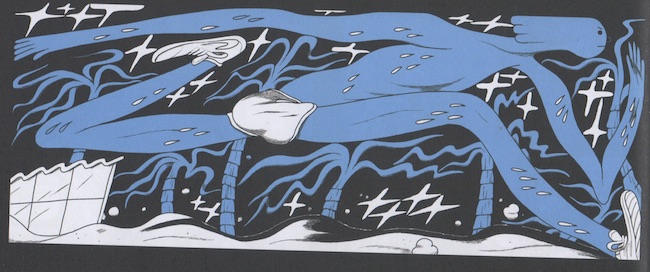Michael DeForge’s new book Stunt has the squat distended proportions of a bookmark or Chick tract. Considerably wider than it is tall, the physically fit body of its stuntman protagonist has to contort himself to fit inside. Largely told in two-panel pages, the few pages that consist of a single image feel like pressed-down parodies of the splash pages in traditional American comics, conveying at first dynamic action within a narrow field, and later homoeroticism, in a space so intimate the body strains against it, dripping with white beads of sweat. When a wider angle is taken to depict a landscape, characters in the background are reduced to feet and heads, like the goombas in Super Mario, or the raccoons in DeForge’s Leaving Richard’s Valley strip, collected into a book earlier this year.
Absent the dialogue that makes the characters in Leaving Richard’s Valley so charming, the story of Stunt is told entirely in captions providing first-person narration. This voice moves things along, not discussing the factors contributing to the stuntman’s depression, but diving right into the present-tense reality of his suicidal ideation. Here as in many other DeForge strips, the psychology is implicit: Motivations are rarely described, but actions proceed through a charged and dreamlike state. Here, those paces return to themes present in other DeForge work. A character looking exactly like a celebrity and having their life transformed is similar to a story in issue 7 of Lose. The desire to act out and transgress that in turn earns the love of the public was a plot element in last year’s Brat. Multiple short stories have depicted gay sex as an unexpected development emerging suddenly in nonromantic relationships.

Such similarities emerge because DeForge is a very prolific cartoonist, and I see them because I basically have a “buy everything I can get my hands on” approach to his work. This behavior puts me in a place where I often read a DeForge comic and feel like I’ve read it before. I try not to hold this against works I have literally encountered before, when books collects short pieces I’ve read in anthologies or online. Still, the work that strikes me is always what feels the most new, when I feel like the artist, for all I’ve seen him do, can still surprise me. I’m sure others with similarly completist approaches are instead looking to see the artist’s pet themes reconfigured anew. I know some people view an obsessive return to similar material as being the mark of an artist, as opposed to the genre-hopping demonstration of range that marks a hack. With DeForge, as with Dennis Cooper or Pedro Almodóvar, a ranking of their work makes distinctions about what is a “distilled” version of their themes vs. what feels like a watered-down retread that will in large part be determined by what work was encountered by the audience first. At a certain level of audience investment, rankings of this type also feel besides the point. DeForge is an artist so sui generis that to use a word like “talented” to describe him can feel like an insult masquerading as faint praise. This puts me in the odd place where I can say something intended as a slight and it will still come off as a pull quote: If you haven’t read a Michael Deforge comic before, you will not have read anything like Stunt.

“Slight” is the one-word negative appraisal, “compressed” would be the positive; both are suggested by a quick glance at the book’s dimensions. It’s reminiscent of other DeForge comics, but it’s also about superficial resemblances turning into a profound relationship that confuses one’s sense of identity. If the self-similarity of the book wasn’t purely unavoidable, it may be intentional. A large part of DeForge’s process is the discarding of works-in-progress he feels are not working or boring in some way. The elements that work may re-emerge in another form. The same process of upcycling which feeds into an unknowable amount of DeForge’s more successful strips here creates a a work that reads like a victory lap of recapitulated material, told in a visual argot readers haven’t quite seen before, but which matches the subject matter in its abstractions of physicality.







